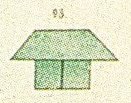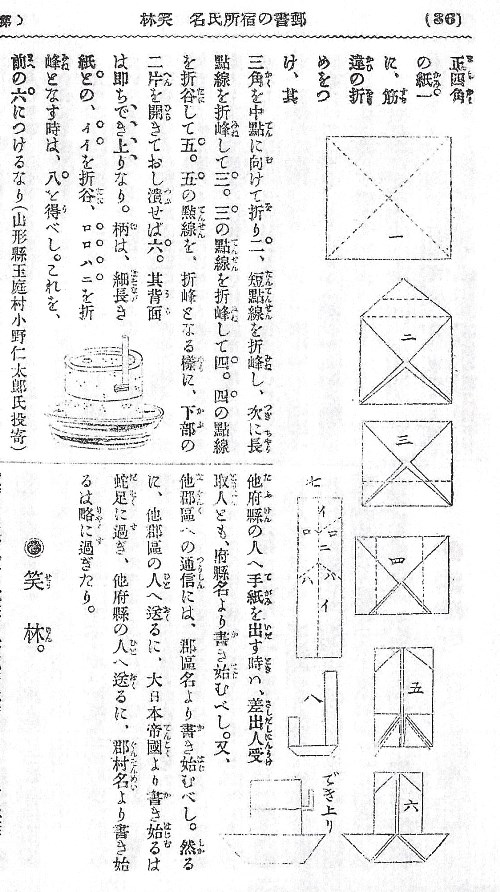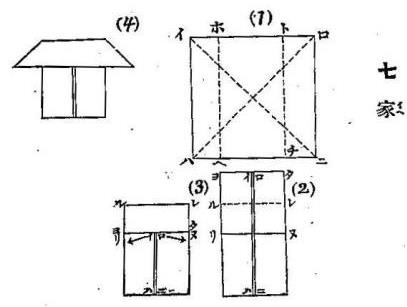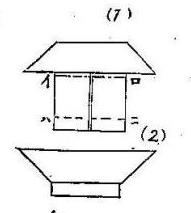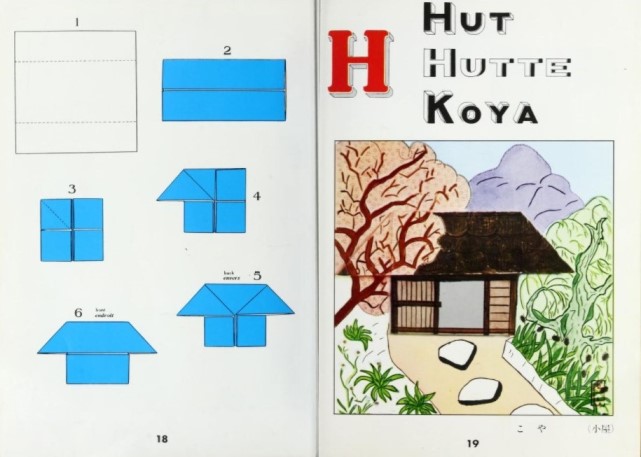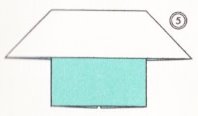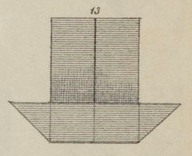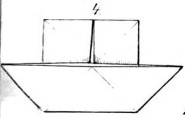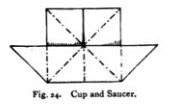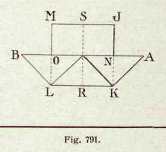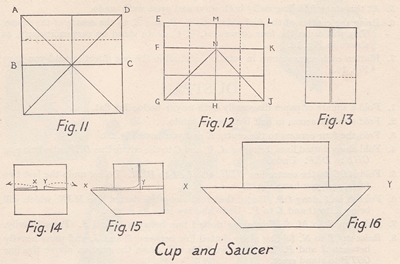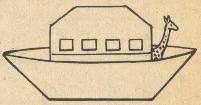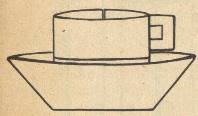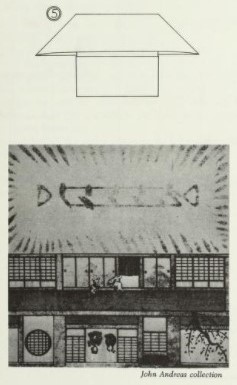| The Public Paperfolding History Project
Last updated 11/11/2025 x |
|||||||
| The Cup and Saucer / The Japanese House | |||||||
| This
page is being used to collect information about the
history of the paperfolding designs known as the Cup and
Saucer and the Japanese House (which is just the Cup and
Saucer turned upside down). Please contact me if you know
any of this information is incorrect or if you have any
other information that should be added. Thank you. Not all the 'Cup and Saucer' or 'Japanese House' designs on this page are made in an identical way. There is a separate page for 'The Monk's Hat', which is a derivative design. ********** In China (and in publications by Chinese authors) 1914 Diagrams for the Japanese House appear in 'Zhe zhi tu shuo' (Illustrated Paperfolding), compiled by Gui Shaolie, which was published by the Commercial Press in Shanghai in Ming guo 3 (1914).
********** In Japan (and in publications by Japanese authors) 1878 As far as I know the design first appears in Japan, in the form of a house, in 'Yochien Ombutsu No Zu', a publication of kindergarten material issued by the Tokyo Women's Normal School in 1878.
********** 1895 A version of the design appears as Hiki-usu (Grindstone and Mortar) in issue 1895 / 11 of the Japanese children's magazine 'Shokokumin'.
********** The design also appears: 1903 In 'Shukouka no Liron Oyobi Jissai' (Handicraft Theory and Practice) by Kuniho Nakamura and Shinpei Ito, which was published by Kofukan in Tokyo in 1903.
********** As 'House' in 'Origami zusetsu' (Illustrated Origami) by Sano Shozo, which was published in Tokyo in 1908.
********** The same book contains a design for a 'Cup' made by pleating the Cup and Saucer design.
********** 1931 As 'Home' in 'Origami (Part 1)' by Isao Honda, which was first published in Japan in 1931.
********** 1944 In 'Origami Shuko' by Isao Honda, which was published in 1944.
********** 1951 In 'Origami: Folding Paper for Children' by Claude Sarasas, which was published by Kodansha in Tokyo in 1951.
********** 1960 As 'A House' in 'All About Origami' by Isao Honda, which was published by Toto Bunka Company, Limited in Tokyo in 1960.
********** As 'A House' in 'Pocket Guide to Origami: Bow-Wow Book', by Isao Honda, which was published by the Asahi Origami Club, Tokyo in 1960.
********** 1965 As 'House' in 'The World of Origami' by Isao Honda, which was published in the USA by Japan Publications Trading Company in 1965.
********** A cut version of the design appears as 'Ship B' in 'Origami in the Classroom: Book 1: Activities for autumn through Christmas' by Chiyo Araki, which was published by Charles E Tuttle Co Inc in 1965.
********** 1970 As 'House' in 'Origami Nippon' by Isao Honda, which is a paperback book published by Honda Origami Studio in Tokyo in 1970.
********** In Europe and the Americas 1861 There is mention of a design titled 'Tasse' (cup) in a list of 'Lebensformen' (Forms of Life) in 'Das Paradies der Kindheit' (The Paradise of Childhood) by Lina Morgenstern, which was published in Leipzig in 1861. Unfortunately the book does not include an illustration of the design. ********** 1863 (Version 1 - made by bookfolding a square and opening out the bottom corners) As far as I know the first illustration of the Cup and Saucer (De kop en schotel) first appears in 'De Kleine Papierwerkers 1: Wat men van een stukje papier al maken kan: Het vouwen' (The Small Paperwork 1: What one can make from a piece of paper: Folding) by Elise Van Calcar, which was published by K H Schadd in Amsterdam in 1863. . ********** 1873 (Version 2 - Made from Kohler's Groundform / The Double Bookfold Basic Form) A different version of this design appears as 'Kaffeetasse' in 'Die Praxis Des Kindergartens' by August Koehler, which was published by Herman Bohlau in Weimar in 1873.
********** The design also appears: 1874 As 'Ein Salonschiff' (a saloon ship) in the revised version of 'Der Kindergarten' by Hermann Goldammer which was published by Carl Babel in Berlin in 1874.
********** 1875 In the second edition of 'Praktischer Wegweiser fur den Unterricht in der Elementarklasse' (Practical Guide for Teaching in the Elementary Class) by Anton Fruhwirth, Alois Fellner and Georg Ernst which was first published by A Pichler's Witwe & Sohn in Vienna in 1875.
********** 1875 As 'De kop en schotel' in 'Froebels Methode' by Elise Van Calcar, which was published in 1875.
********** 1877 (Version 2 - Made from Kohler's Groundform / The Double Bookfold Basic Form) As 'The Inkstand', in 'Kindergarten Practice' by Mary Gurney, which is a substantially abridged version, in two parts, of 'Die Praxis Des Kindergartens' by Auguste Koehler. The second part, 'Froebel's Plane Surfaces', contains sections dealing with paper folding, cutting and weaving. The date of the first edition is not known. The second edition was published in 1877 in London by A N Myers and Co.
********** 1880 In 'Maakt de Kinderen Gelukkig' by Elise Van Calcar, which was published by H C Van Calcar in Gravenhage in 1880, there is reference to this design as 'kopje' (cup) and 'schoteltje' (saucer), although no illustration is provided. ********** 1893 In 'Paper and Scissors in the Schoolroom' by Emily Weaver, which was published by Milton Bradley Company in Springfield, Massachusetts in 1893
********** 1895 As 'A House-Boat' in 'Course of Paperfolding' by Eleonore Heerwart, which was published by Charles and Dible in London and Glasgow in 1895, in a section about designs developed from Kohler's Groundform / The Double Bookfold Basic Form.
********** 1910 As 'Tasse' (Cup) in 'Allerlei Papierarbeiten' by Hildergard Gierke and Alice Kuczynski, which was published by Drud und Verlag B G Teubner in Leipzig and Berlin in 1910.
(Illustration in book is the other way up) ********** As 'Cup and Saucer' in 'Educational Handwork' by T B Kidner, which was published by The Educational Book Company Limited in Toronto in 1910.
********** 1918 The same design appears as 'Taza' in 'Ciencia Recreativa' by Jose Estralella, which was published by Gustavo Gili in Barcelona in 1918.
********** 1937 (Version 3 - Similar to Version 1 but with the top quarter of the square folded downwards first.) In 'Paper Toy Making' by Margaret Campbell, which was first published by Sir Isaac Pitman and Sons Ltd in London, probably in 1937, although both the Foreword and Preface are dated 1936, which argues that the book was complete at that date.
********** 1949 (Version 4) The design also appears in three variations, as a house, Noah's Ark (L'Arche de Noe) and a cup and saucer (La Tasse), in 'Au Pays des Mains Agiles', which was published by Editions Fleurus in Paris in 1949.
********** 1961 The Japanese House also appears in 'The Art of Origami' by Samuel Randlett, which was published by E P Dutton in New York in 1961. The book also includes a photograph of a Japanese pre-printed sheet for this design from the John Andreas collection.
********* 1970 As 'House' in 'Be Somebody! Colorgami Book 1' by Joleen Young, which was published by Young Handicraft Company in the USA in 1970.
********** |
|||||||

